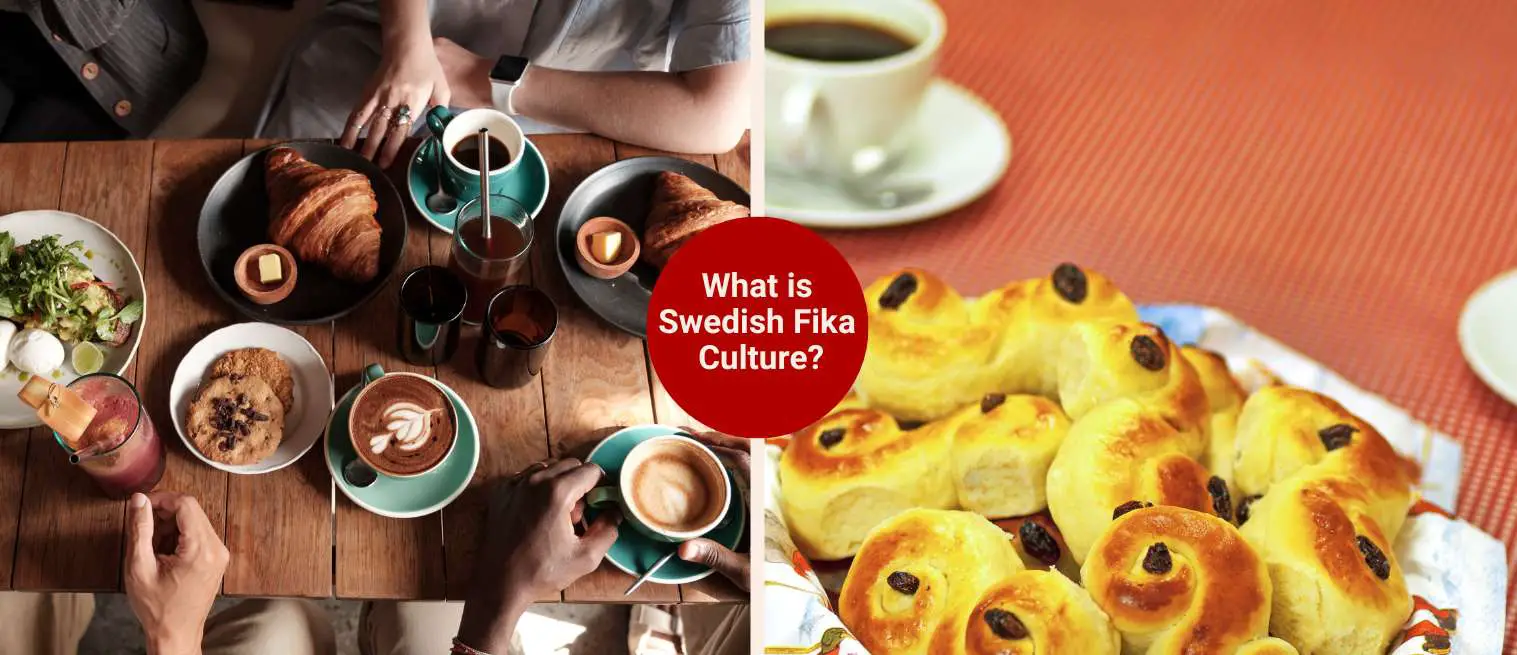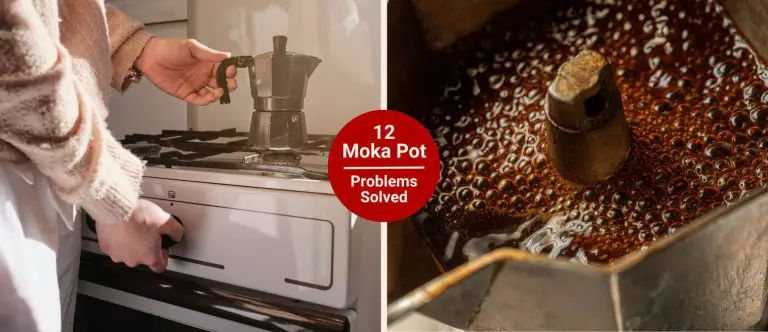What Is Swedish Coffee and Fika Culture? (Full Guide)
Last updated on August 28th, 2025 at 10:50 am
Ever wondered why Sweden takes its coffee breaks so seriously?
I’ve written about the coffee culture from several countries. From Italy, France, Portugal (me being Portuguese). All of them have their unique drinks and traditions.
However, out of all, I’d say Sweden is the most surprising. I have a friend from Uppsala who once told me, “If you skip fika, people worry about you.” At first, I thought she was joking. But no, fika is almost sacred.
In this guide, you’ll discover what makes Swedish Coffee and Fika Culture special.
This includes why it’s more than sipping coffee, the kinds of brews Swedes prefer, the classic treats they pair it with, and how you can bring this ritual to your daily routine.
Key Takeaways
- Fika is more than a coffee break – It’s a cherished Swedish tradition that blends social connection, mindfulness, and a moment of pause, typically shared over coffee and a sweet treat.
- Swedes love their drip coffee – Medium to dark roast filter coffee (bryggkaffe) is the go-to, and Sweden ranks among the top coffee-consuming countries in the world.
- Classic fika treats matter – Think cinnamon buns (kanelbullar), cardamom pastries, cookies like drömmar, or a hearty smörgås. The treat is just as important as the coffee.
- You can enjoy fika at home – Slow down, unplug, brew a fresh cup, and enjoy it solo or with a friend. A cozy mug, candlelight, and a little intention go a long way.
What Is Fika?
The first time I heard the word fika, I thought it was just Swedish for coffee. I was way off! It’s more like a lifestyle, a mindset… a ritual disguised as a snack break.
More Than a Coffee Break
Fika isn’t just grabbing a latte and scrolling your phone. Instead, it’s the moment when Swedes take a pause. Usually, mid-morning and again mid-afternoon to drink coffee, eat a little something sweet (like cinnamon buns, cookies, semlor if you’re lucky), and connect.
Now, the word itself? A bit of linguistic. Well, it’s a backslang version of “kaffe” (Swedish for coffee). You flip the syllables, and you get “fika.” It dates back to the late 1800s, when café culture started growing in Sweden.
However, it’s not only a tradition, but it also supports Swedes emotionally. In a country that’s cold and dark for nearly six months of the year, these cozy, caffeine-fueled pauses mean everything
They’re how Swedes warm up (literally and emotionally), share laughs, air complaints, or chill with silence over a strong cup of medium-dark roast.
Notes: Another part is that fika isn’t rushed. It’s not some corporate ploy to bond. It’s expected. If you skip fika, people notice. It’s like not making eye contact during a handshake.
Fika at Work and Home
In Sweden, fika isn’t only a break as mentioned. Instead, it’s a respected part of the daily routine. Most workplaces pause mid-morning and again in the afternoon to encourage socializing over coffee and a light treat.

Furthermore, it isn’t unusual for companies to formally include fika breaks in employee schedules. At home, fika feels even more personal. It’s how you welcome guests, catch up with family, or enjoy a quiet moment to yourself.
Offering coffee and something sweet within minutes of someone arriving is a gesture of warmth and skipping it might come off as a little impolite.
Swedish Coffee Preferences
Swedes don’t only drink coffee. Rather they commit to it, cup after cup, day after day. So let’s go more in-depth:
Brew Style & Roast Level
Swedes love their bryggkaffe. That’s drip coffee brewed the good old-fashioned way. It’s clean, smooth, and made to sip slowly.
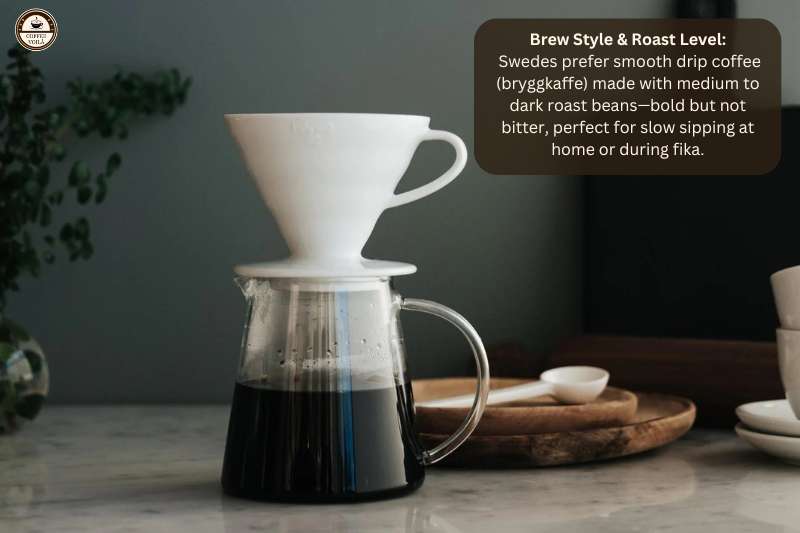
Most people go for a medium to dark roast, something comforting with a little depth but not too smoky. For instance, Löfbergs is a well-known Swedish brand you’ll see everywhere, and their “Medium Roast” is kind of a classic for a reason.
I’ve brewed it at home before and it holds up black or with a splash of milk, which is basically how most Swedes drink it.
What about Number?
Sweden consistently ranks in the top 5 for coffee consumption per capita in the world. We’re talking around 8.2 kg per person per year. That’s more than double the average American. So yeah, Swedes take their coffee very seriously.
Popular Brewing Methods in Sweden
When it comes to how coffee is brewed, there’s a lot of tradition mixed with personal flair.
Melitta-style Pour-Over
This one’s common in Swedish homes and pretty easy. You use a cone-shaped filter (Melitta-style) and pour hot water in circles over the grounds.
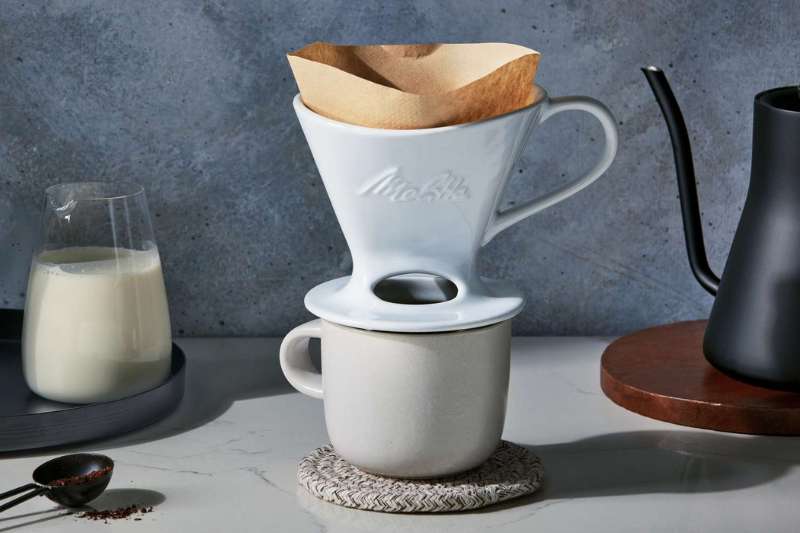
It’s low-maintenance, and it brings out the lighter notes in the coffee. Some people even hand-pour without scales or gooseneck kettles (just muscle memory and routine).
Moka Pot
You’ll find moka pots in a surprising number of kitchens, especially for those who want something a bit bolder. It’s not an espresso machine, but the pressure gives a richer body than drip.

Some Swedes brew their weekend morning pot this way, particularly if they’re pairing it with a big cinnamon bun.
Kokkaffe (Boiled Campfire Coffee)
Kokkaffe is the nostalgic method, specifically for outdoor lovers. You boil coarse grounds right in a pot (no filter), usually over a campfire or stovetop.
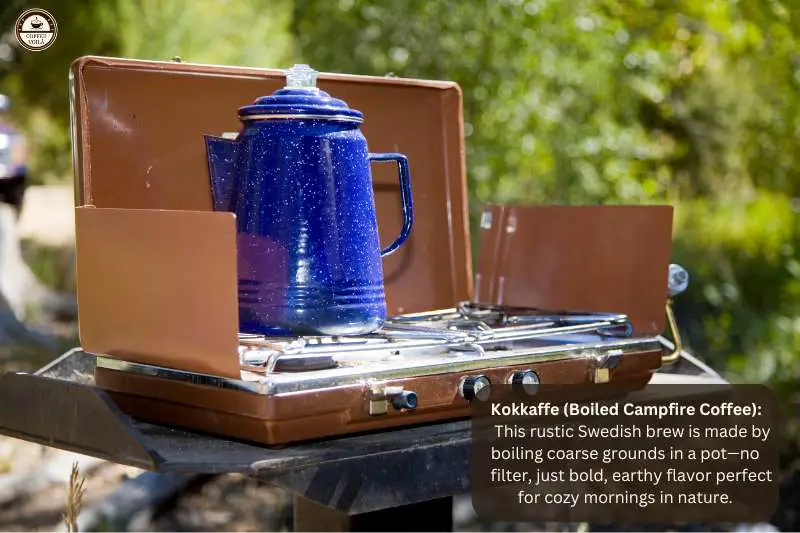
Afterward, you let it steep a bit, then pour slowly to avoid the sludge. The flavor’s strong and earthy. It’s perfect for those cold, quiet mornings in a cabin.
Notes: So whether it’s a quiet pour-over in the kitchen or smoky kokkaffe by a lake, the Swedish approach to brewing is all about comfort, consistency, and never being far from your next cup.
Classic Fika Treats
Now let’s talk about what Swedes pair their coffee with. I’d say, once you’ve had coffee with these classics, plain toast just doesn’t cut it anymore.
Kanelbullar (Cinnamon Buns)
Basically, these are the heart and soul of fika. The buns aren’t overly sweet, they’ve got a good hit of cinnamon and the right amount of chew.

The best kanelbullar have a soft interior and golden crust, with pearl sugar on top that gives a nice crunch. They pair ridiculously well with black coffee, especially bryggkaffe.
Cardamom Buns (Kardemummabullar)
These buns smell floral but punchy, and the taste is more layered than cinnamon buns. A bit earthy, a little spicy, and pretty addictive.
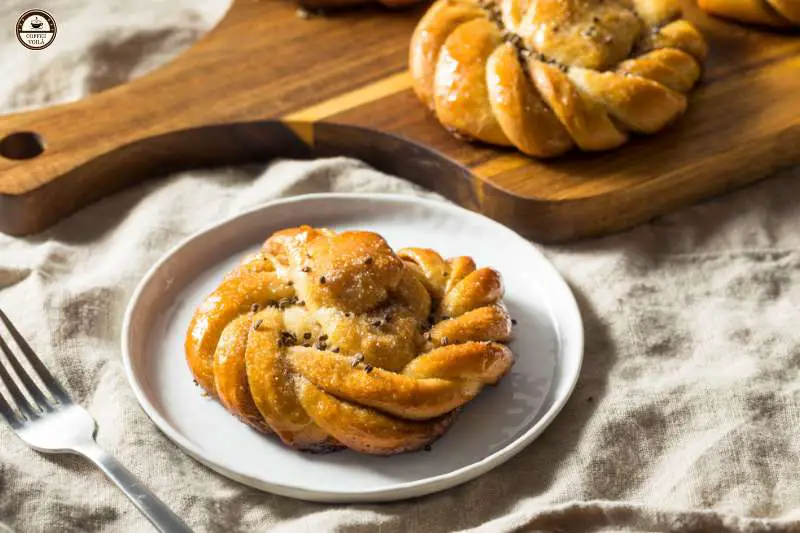
Swedes love cardamom in everything, and this bun shows why. They’re twisted in that beautiful knot shape and commonly less sugary. I also suggest to warm it up slightly before eating.
Cookies like Drömmar and Pepparkakor
Drömmar means “dreams”. These vanilla-scented butter cookies crumble in your mouth, almost like shortbread but lighter. You don’t dunk these; rather, you savor them.
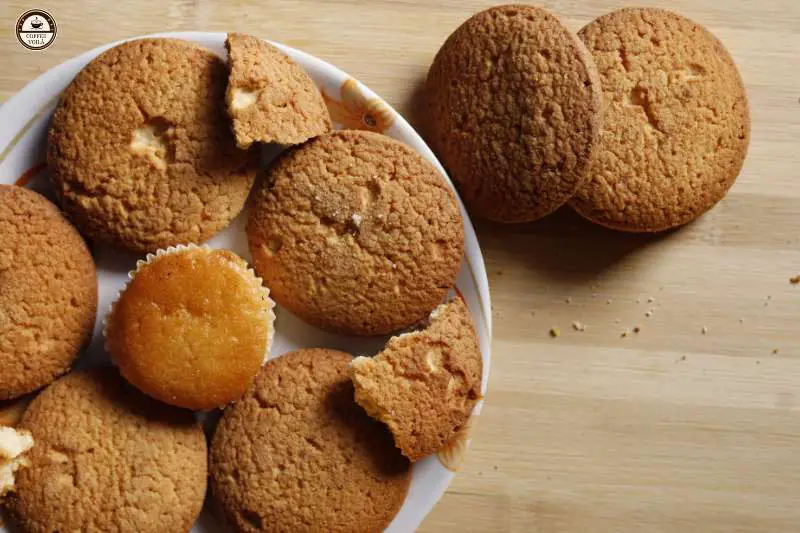
And then there’s pepparkakor, Swedish ginger cookies. Thin, snappy, and spiced with clove and cinnamon. I’ve seen people make heart or goat shapes around Christmas. However, they’re good all year.
Smörgås (Open-Faced Sandwiches)
If sweet isn’t your thing, fika’s still got your back. A classic smörgås with butter, cheese, and maybe a slice of cucumber or boiled egg can anchor the moment.

I once had one topped with shrimp salad and dill, and let me tell you, I did not expect it to work with coffee but it weirdly does. Usually, the bread’s rye or sourdough, and it’s always fresh.
How to Enjoy Fika at Home?
You don’t need to live in Sweden to embrace Fika. With a few small tweaks to your routine, you can turn your daily coffee into a comforting, feel-good ritual.

Step 1) Set the Mood: Slow Down, Unplug, Create Comfort
Before anything else, pause. The fact is Fika isn’t meant to be crammed in between Zoom meetings or while scrolling your phone. It’s a chance to mentally and emotionally step back.
I like to start by clearing a little space, lighting a candle (yes, even if it’s daytime), and setting down my phone.
You could even play something instrumental in the background, such as soft jazz, acoustic, or even ambient Nordic tunes. Also, add a cozy throw, open a window for some fresh air, and let the moment breathe a little.
Step 2) Invite a Friend or Take a Mindful Solo Break
Fika can be social or completely solo. If you’ve got a close friend nearby, invite them over for a slow coffee and a chat.
When I do it alone, I’ll pour my coffee and journal for ten minutes or sit quietly by the window. That little pause in the day gives me more clarity than I ever expected. Even 15 minutes makes a big difference.
Step 3) Brew Coffee Fresh and Serve with a Treat
Coffee is central to Fika. This means you want to brew it fresh. Typically, Swedes go for bryggkaffe (drip coffee). However, I’ve used a French press or even a moka pot and it still hits the spot.
The treat is as important. I recommend a cinnamon bun (kanelbulle), a cookie like pepparkakor, or a buttery slice of toast with cheese.
Notes: Serving your coffee in a thick, warm mug makes it feel richer. Even if the rest of your day is chaos, this little window can feel like your own peaceful corner of Scandinavia.
Why Fika Matters in Modern Life?
We’re always glued to our phones, juggling deadlines, and feeling like there’s never enough time. But fika? It’s like someone hit pause on the madness and you actually breathe. So, here are some benefits I’ve noticed:
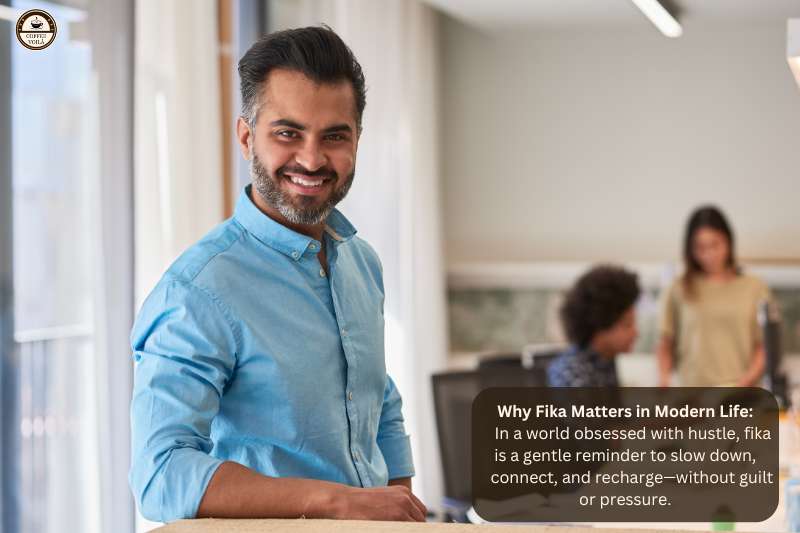
Mental Health and Productivity Benefits
I used to think taking breaks was lazy. Then I tried a proper fika-style pause. You take ten minutes with a hot cup of coffee and a small cinnamon bun… and I swear, I came back to work sharper and calmer.
Plus, studies back this up, too. Regular short breaks help reduce stress and improve focus. There’s something about stepping away without guilt that resets the brain.
Cultural Values of Balance, Community, and Pause
Fika is about making space for connection and not just caffeine. Whether it’s chatting with a colleague or being present with your thoughts, it reminds you that life’s not only about productivity.
I’ve had some of my best conversations over fika. And honestly, it’s taught me more about hospitality than any etiquette guide. Whenever you offer someone coffee and a pastry is like saying, “You matter. Let’s slow down together.”
Contrast with Hustle Culture
We rush through breakfast, skip breaks, power through lunch at our desks… sound familiar? Hustle culture makes rest feel like failure. Meanwhile, Fika flips that script.
Instead of squeezing in a coffee run between tasks, fika invites you to stop completely and take a break. Not because you’ve earned it, but because you need it.
And that shift? It’s subtle but powerful. It tells you that you’re not a machine. But you’re human and humans need to pause.
Note: So next time you’re powering through your to-do list, take a moment to stop and brew a cup. And while you’re at it, grab a biscuit and fika your way back to sanity.
Last Thoughts
So have you tried Fika yet? Whether you’re sticking to cinnamon buns and black coffee or swapping in a vegan cookie and your favorite oat latte, I’d love to hear how you’ve made it your own.
Do you have any cozy rituals, go-to treats, or even a Spotify playlist that sets the mood? I’d like to read your comments.
And hey, if you’re Swedish what did I miss? What’s your personal spin on this beloved pause in the day? I’d love to hear.
Questions? We Have Answers.
Get answers to a list of the most Frequently Asked Questions.

